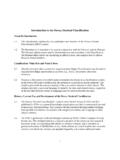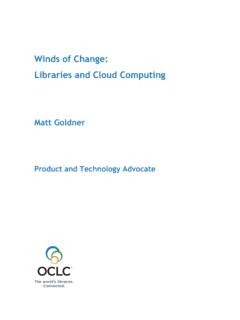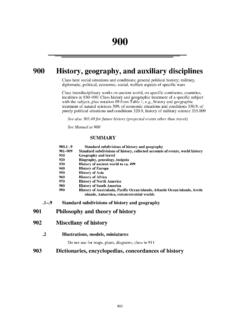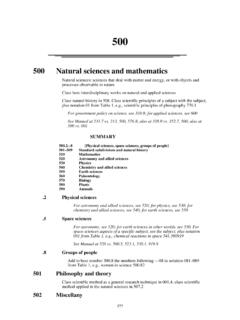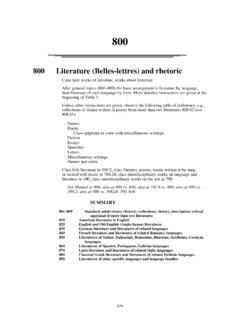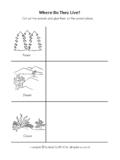Transcription of The Library in the Life of the User: Engaging with People ...
1 The Library in the life of the user Engaging with People where they live and Learn Compiled and co-authored by Lynn Silipigni Connaway The Library in the life of the user : Engaging with People where they live and Learn This compilation is 2015 OCLC Online Computer Library Center, Inc. Individual copyright and licensing details related to the papers included in this compilation are noted on their respective cover pages. October 2015. OCLC Research Dublin, Ohio 43017 USA. ISBNs: 1-55653-500-7 (978-1-55653-500-0). OCLC Control Number: 924929722. Please direct correspondence to: Lynn Silipigni Connaway Senior Research Scientist, OCLC Research Suggested citation: Connaway, Lynn Silipigni, comp. 2015. The Library in the life of the user : Engaging with People where they live and Learn. Dublin, Ohio: OCLC Research. org/content/dam/research/publications/20 15 We've normalized some of the references and URLs in this report for consistency.
2 URLs that were not working at the time of publication were noted and their hyperlinks were removed from the PDF file of this report. Alternative links were included when possible. The pagination in these reports differs from the originals. Please keep this in mind when citing this work. ACKNOWLEDGMENTS. The research represented in this compilation was made possible by several strategic partnerships as well as funding for several of the projects by the Institute of Museum and Library Services (IMLS), in collaboration with The Ohio State University and Rutgers, The State University of New Jersey, and with Jisc, in collaboration with Oxford University and the University of North Carolina, Charlotte. Special thanks to Lorcan Dempsey for popularizing the phrase The Library in the life of the user and also to the following colleagues for their help in editing and publishing this report: Melissa Renspie, Erin Hood, Linda Shepard, Brad Gauder, Jeanette McNicol, Matt Carlson and Eric Childress.
3 CONTENTS. Introduction, by Lynn Silipigni Connaway.. i 1. Reordering Ranganathan: Shifting user Behaviours, Shifting Priorities, by Lynn Silipigni Connaway and Ixchel M. Faniel .. 1. 2. What is Enough? Satisficing Information Needs, by Chandra Prabha, Lynn Silipigni Connaway, Lawrence Olszewski and Lillie Jenkins.. 33. 3. Screenagers and live Chat Reference: Living Up to the Promise, by Marie L. Radford and Lynn Silipigni Connaway .. 51. 4. Sense-making and Synchronicity: Information-seeking Behaviors of Millennials and Baby Boomers, by Lynn Silipigni Connaway, Marie L. Radford, Timothy J. Dickey, Jocelyn De Angelis Williams and Patrick Confer .. 79. 5. The Digital Information Seeker: Report of Findings from Selected OCLC, RIN. and JISC user Behaviour Projects, by Lynn Silipigni Connaway and Timothy J. Dickey .. 97. 6. If it is too inconvenient I'm not going after it: Convenience as a Critical Factor in Information-seeking Behaviors, by Lynn Silipigni Connaway, Timothy J.
4 Dickey and Marie L. Radford.. 107. 7. user -centered Decision Making: A New Model for Developing Academic Library Services and Systems, by Lynn Silipigni Connaway, Donna Lanclos, David White, Alison Le Cornu and Erin M. Hood.. 135. 8. Visitors and Residents: What Motivates Engagement with the Digital Information Environment? by Lynn Silipigni Connaway, David White, Donna Lanclos and Alison Le Cornu.. 153. 9. I always stick with the first thing that comes up on Google.. where People Go for Information, What they Use, and Why by Lynn Silipigni Connaway, Donna M. Lanclos and Erin M. Hood.. 169. 10. Meeting the Expectations of the Community: The Engagement-centered Library , by Lynn Silipigni Connaway.. 197. INTRODUCTION. The study of user behaviors, also referred to as information behavior, information-seeking behavior research, or user studies is not a new line of inquiry.
5 In 1931, Ranganathan wrote, Perhaps the most convenient method of studying the consequences of this law will be to follow the reader from the moment he enters the Library to the moment he leaves it (337). This reference to follow the reader sounds very similar to the ethnographic studies and observations that have become more prevalent in LIS user behavior research. In 1940, when making a case for local funding of public libraries, McDiarmid stated: In order to answer the question, What type of Library service is needed in the community?' a great deal must be known regarding the area to be served. What are the important factors in the Library 's community environment? What social changes have altered this environment? These are questions which require historical, geographical and social data and, hence, an important part of an effective Library survey is a study of the community itself.
6 (11). The current economic climate, much like the environment McDiarmid described in 1940, has drawn much attention to assessment in school and academic libraries as a way to articulate the value of libraries within the academic environment. Assessment involves analyzing the data made available through educational systems to measure student success, such as retention and GPA, against service and resources provided by the Library . It also involves utilizing the data generated by Library systems and services, such as web analytics and feedback from those within the academic community regardless of whether they use the Library . If they do use the Library , it is imperative to identify how and why they use it. If they do not use the Library , it is equally important to discover how and what they use to get their information and to learn why they use these services and resources instead of those provided by the Library .
7 We refer to this as user -centered assessment (Connaway 2014b). Since the Library is not the only game in town to get information and the majority of the population does not use libraries to get information (Connaway 2013, 83), it is important for the Library to become embedded in the lifestyles of their users and potential users (those who may not or who seldom use Library services).1. Introduction i As a way to put this into a practical perspective, Dempsey (2015) discusses the importance of thinking about the Library in the life of the user instead of the traditional model of thinking of the user in the life of the Library . Again, this leads back to the fact that there are many more convenient and familiar ways of getting information today than from the traditional Library environment. Many People do not think of the Library as the first place to get their information.
8 This may be attributed to People not knowing that the services exist or that some of the existing services are not familiar or do not fit into their workflows. Research indicates that People associate the Library with books and do not consider the Library in relation to online resources or reference services (Connaway, Dickey, and Radford 2011; Connaway, Lanclos, and Hood 2013;. Connaway and Radford 2011; De Rosa et al. 2005; De Rosa et al. 2010; Prabha, Connaway, and Dickey 2006), which could be addressed with branding initiatives and marketing campaigns. To address these issues we have developed an OCLC research theme titled user studies. The rationale for this research activity is that by providing the Library community with behavioral evidence about individuals' perceptions, habits, and requirements, we can ensure that the design of future Library services is all about the We have concentrated on identifying how People engage with technology and get their information for both personal and academic situations.
9 We have learned that the context and situation of the information need often dictate how People behave and engage with technology. These also influence how and why they select to use resources, usually discovered through a web browser and that include freely available resources, such as Wikipedia; human resources; and Library resources. Our research indicates the importance of developing relationships and Engaging with People . If they know us and trust us, they will seek us out when they need information and they will recommend us and our services to others. When asked to identify successful virtual reference encounters users cited instances when they did not receive an answer, but when they had a good rapport with the librarian and the librarian was kind and helpful. This exemplifies the importance of engagement and relationship building in both the online and physical environments for the development of successful and effective services.
10 Based on our research, the following questions were asked in the comments on The Elusive user blog post (Connaway 2014a). 1. If we try to identify how People find information and how and why they get their information as well as how and why they choose to engage with specific technology, could we, as librarians, provide services and systems that will meet some of these needs? 2. Is this attempting to take on more than librarians have the capacity to do, especially in today's environment of limited resources, or, is this something that we have an interest in pursuing? 3. Should we only concentrate on those who currently use our resources and services, subsequently developing personalized or boutique Library services (Priestner and Tilley 2012)? These are questions that need to be openly discussed in order to develop a research agenda, recommendations, and a plan for integrating the Library into the life of the user .
